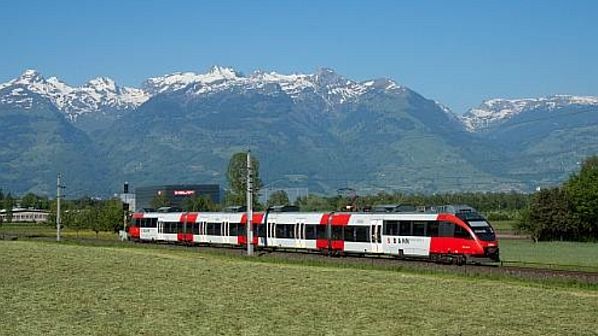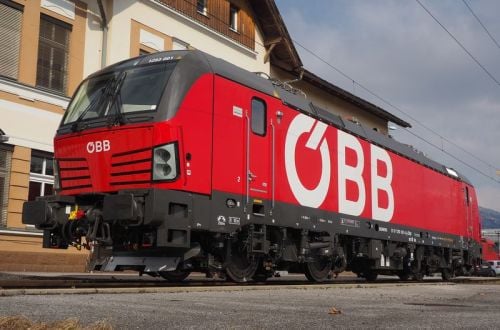The investments are part of the railway’s €17.5bn 2021-2026 framework plan, which was approved by Austria’s council of ministers in October. The framework outlines investments of around €3bn per year over six years in support of ÖBB’s Target Network 2025+ strategy plan. The funds are intended to contribute to the development of modern, high-performance infrastructure in Austria and increase the attractiveness and efficiency of rail travel for passengers and freight.
Upper Austria
ÖBB will invest €265m in its 878km Upper Austrian network. A key focus of the investment is the quadrupling of track on sections of the region’s Western Railway. Work began in 2019 on the Linz - Wels section, with construction of the Marchtrenk - Wels section set to begin in the summer. Approval of the Linz - Marchtrenk section is also expected this year.
ÖBB will carry out an environmental impact assessment for the Linz Kleinmünchen - Linz Central of the Western Railway, the last section which must be submitted for approval to enable the construction of a continuous four-track line between Vienna and Linz.
Approval of the Köstendorf - Salzburg section is also currently underway, and ÖBB is set to continue its programme of upgrades to increase capacity at the Linz and Wels marshalling yards.
ÖBB will also carry out an environmental impact assessment for track doubling of the Hinterstoder - Pießling-Vorderstoder section of the Pyhrn branch line in 2021.
In addition, the investment will also support ÖBB’s station refurbishment programme. Stations undergoing renovation in 2021 include Bad Goisern, Bad Goisern Jodschwefelbad, Steyregg, Lungitz, St Georgen, Gunskirchen, Schwanenstadt, Ennsdorf, Gusen and the Katsdorf stop. These projects are also supported by the state of Upper Austria as part of its 2019 Attractiveness Package. The reconstruction of the Micheldorf and Kremsmünster stations is in the planning stage.
Vienna, Burgenland and Lower Austria
ÖBB will invest €700m to improve rail infrastructure in Austria’s easternmost regions of Vienna, Lower Austria and Burgenland. The networks in these regions serve two thirds of all Austrian rail traffic.
Among the projects are updates to Matzleinsdorfer Platz, Franz-Josefs-Bahnhof, Grillgasse and Strebersdorf stations, as well as the completion of work at Praterstern station.
The investment will also be used to support upgrades to the Meidling - Floridsdorf line (planned to begin construction in 2022); improvements to the attractiveness of the Hütteldorf - Meidling commuter line (beginning 2023); and construct a four-track extension to the Meidling – Mödling line (beginning 2027).
The funds will also support improvements to the Vienna- Bratislava, Slovakia, cross-border route, which will create a double-track, electrified rail connection between the two capitals. Work is scheduled to begin in the spring. The funding will also support track doubling on the Vienna section of the Pottendorfer line, which will start at the end of the year. Improvements to the Northern Railway between Vienna Sußenbrunn and Berhardsthal in Lower Austria will also be carried out, enabling shorter travel times for European long-distance traffic to the Czech Republic, Poland and East Germany, as well as improved services for local commuters.

In addition, funding will support preparatory work for projects such as planning for the electrification of the Eastern Railway between Jennersdorf and Graz, and the Wiener Neustadt - Schattendorf - Loipersbach Mattersburger railway, and route selection for a new rail link connecting Vienna Airport with Burgenland and Lower Austria, which is scheduled to begin construction in 2025. Plans for the Ebenfurth rail bypass will also be presented to the public in 2021.
ÖBB will also construct a new railway training facility in St Pölten, which will open in April 2022.
Vorarlberg
ÖBB will €66m in the modernisation of rail infrastructure in Vorarlberg in 2021, and will cover an expansion of capacity on the Lustenau - Lauterach line to enable half-hourly S-Bahn services. Modernisation work at Altach station is due to be completed in May, alongside improvements to other stations. ÖBB will also carry out modernisation of its Spullersee power plant in 2021, as well as well as maintenance work on the regional network.
Carinthia
ÖBB has allocated €408m to the 516km Carinthia regional network this year. A key target of funding will be the construction of region’s section of the new 127km Koralm Railway, which will link the regional capital of Klagenfurt, Carinthia, with the city of Graz, Styria, and which includes the 33km-long Koralm Tunnel.
In addition, the funds will also support modernisation work on the 8km cross-border Karawanken tunnel, due for completion in September, the electrification of the Klagenfurt - Weizelsdorf route, due to begin in March for completion in 2023, and the construction of a new power plant at Obervellach.
Styria
ÖBB will invest €530m in the 792km Styrian regional network this year. The funds will primarily support the construction of the Styrian section of the Koralm Railway, the ongoing construction of the 27km-long Semmering Base Tunnel, and the modernisation of the Ennstal Railway, the Styrian Eastern Railway, and the Salzkammergut Railway.
Salzburg
ÖBB will invest €160m in the 245km Salzburg regional network. The funds will primarily be used to support construction of ÖBB’s new pumped storage power plant in Pinzgauer Stubachtal, due for completion in 2025, electrification of the Steindorf - Straßwalchen West - Friedburg S-Bahn line, and the construction of electronic interlockings in Munderfing, Mattighofen and Mauerkirchen.
In addition, the alignment of the Salzburg - Bischofshofen line will be improved around Golling, while funds will support an ongoing environmental impact assessment for the potential quadrupling of track on the Salzburg western section of the Köstendorf - Salzburg line. ÖBB will also construct new nine-track sidings at Salzburg Main Station, which will be completed in July.
Part of the funding will support routine maintenance across all the regions, as well as make improvements to level crossings, platforms and other trackside infrastructure.

